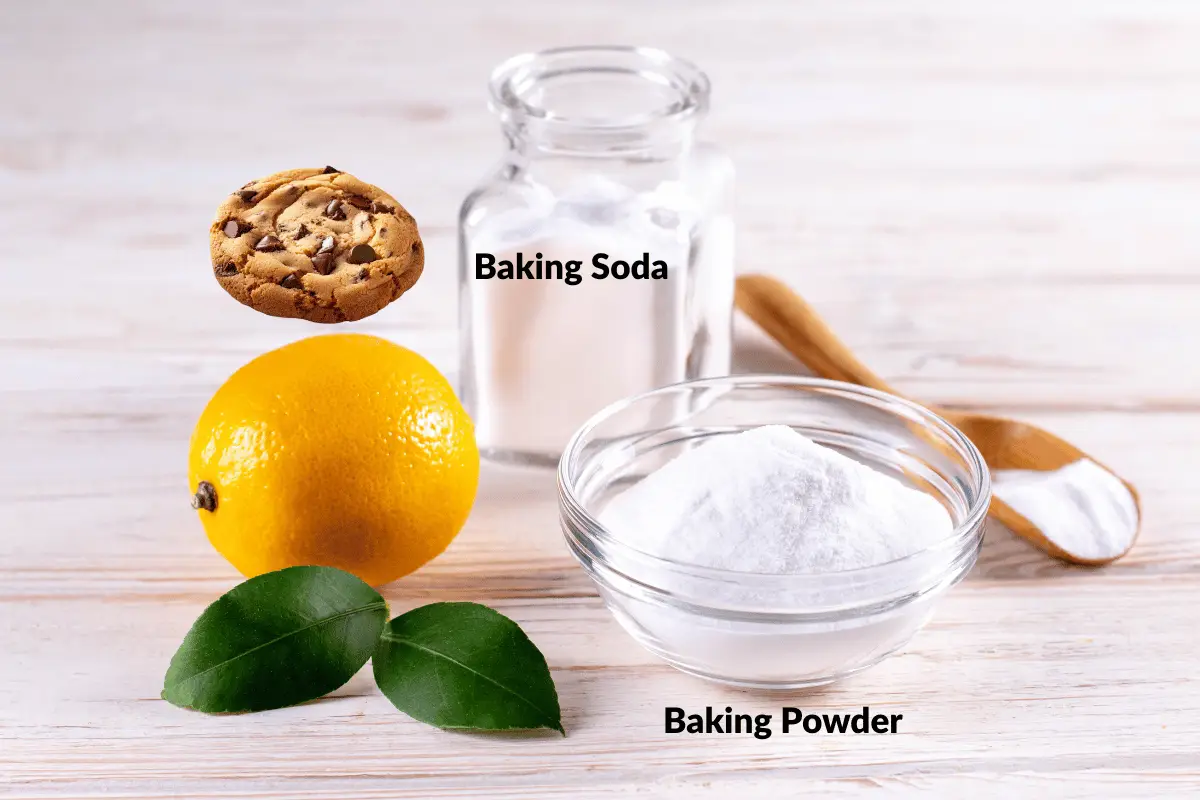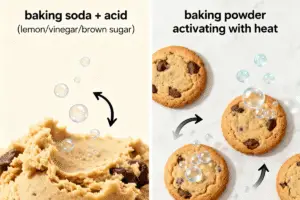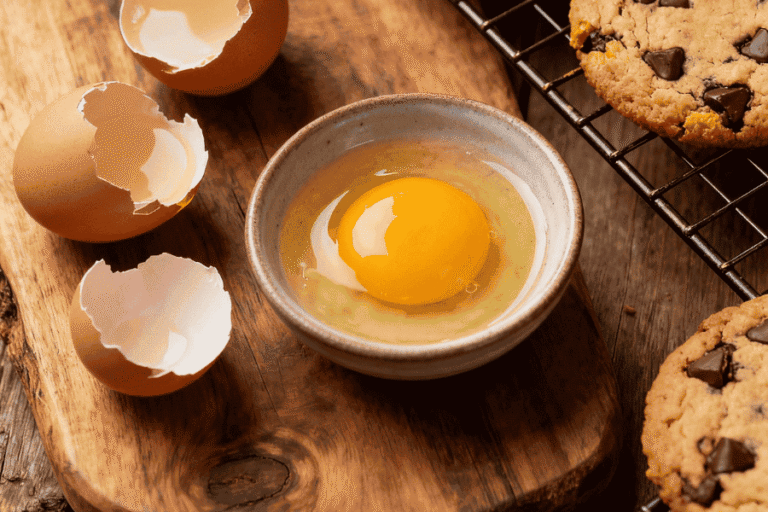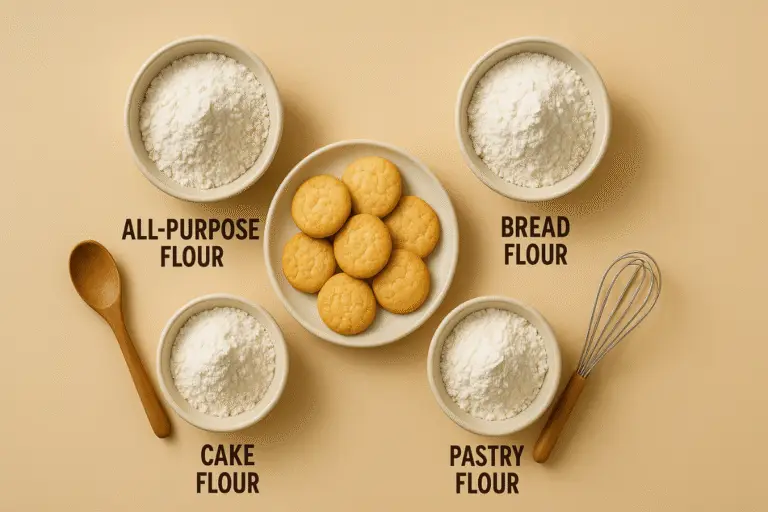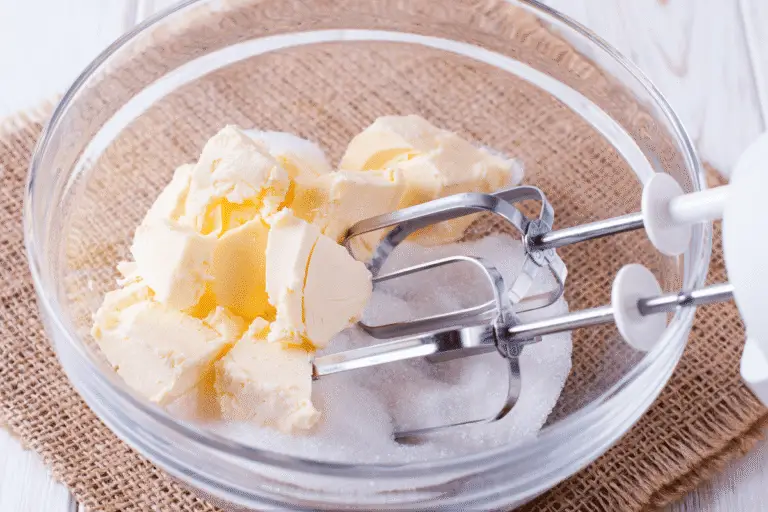When it comes to baking cookies, few topics cause more confusion than baking soda vs baking powder in cookies. Many bakers, even experienced ones, find themselves asking, “Is baking soda the same as baking powder?” While the two look similar, they work very differently, and using the wrong one can completely change your cookie results.
After working in the cookie industry for 17 years, I have tested both ingredients in countless recipes, from chewy chocolate chip cookies to delicate sugar cookies. What I have learned is simple: baking soda and baking powder are not interchangeable and understanding when to use each is the key to mastering cookie texture, flavor, and spread.
In this guide, we will break down the science behind each leavening agent, how they affect your cookies, and when to choose one over the other. You will also learn pro-level tips, substitution tricks, and answers to the most common questions bakers have about these two essential ingredients. By the end, you will know exactly how to pick the right one for the perfect batch of cookies every time.
While understanding leaveners is a huge step toward mastering baking, they are just one part of the puzzle. See how they work together with flour, fat, and sugar in my ultimate guide to basic cookie ingredients.
The Role of Leaveners: What Does Baking Soda vs Baking Powder Do in Cookies?
At first sight, baking soda and baking powder may look the same as fine white powders but the way they work in your cookie dough is very different. Both are leavening agents also called as raising agents, meaning they help your cookies rise, spread, and achieve the right texture. But the science of leavening explains why they cannot simply replace each other.
What Does Baking Soda Do in Cookies?
Baking soda (sodium bicarbonate) is a base that reacts when it comes into contact with an acid (such as brown sugar, yogurt, lemon juice, or molasses). This reaction produces carbon dioxide gas, which creates air pockets and helps cookies spread and rise slightly.
This chemical reaction is why recipes with baking soda often include an acidic ingredient like buttermilk, cream of tartar, or most commonly, brown sugar. The choice of sugar is critical for leavening, which I cover in my detailed comparison of brown sugar vs. white sugar in cookies.
- Texture effect: Baking soda encourages cookies to spread more, giving them crisp edges with a chewy center.
- Color effect: It raises the dough’s pH level, which speeds up the Maillard reaction, leading to browner, richer-colored cookies.
- Flavor effect: A higher pH also softens acidity, giving cookies a deeper, more complex flavor (especially noticeable in chocolate chip or molasses cookies).
Pro insight (from 17 years in the cookie industry): When I want a chewy cookie with golden-brown edges, baking soda is my go-to leavening agent.
What Does Baking Powder Do in Cookies?
Baking powder is a complete leavening agent because it contains baking soda plus a powdered acid (like cream of tartar) and a moisture absorber (cornstarch). This means it can react on its own without needing extra acidic ingredients in the dough.
- Texture effect: Baking powder produces a more controlled rise, giving cookies a lighter, fluffier, cake-like texture.
- Color effect: Because it doesn’t significantly raise the dough’s pH, cookies made with baking powder are usually lighter in color than those with baking soda.
- Flavor effect: It contributes a neutral taste, so the other flavors like vanilla or chocolate stand out more clearly.
Pro insight: If a cookie recipe doesn’t contain enough acidic ingredients, I use baking powder to achieve lift without sacrificing flavor balance.
Because baking powder provides its own acid, it creates a powerful lifting action, resulting in a thicker, more cake-like cookie. This makes it a key ingredient to consider if you’re struggling with the problem of why your cookies are flat.
Industry Insight: Biscuits vs. Cookies
In the biscuit industry, it’s unusual to use blended baking powders. Instead, the soda and acid salts are added separately, allowing manufacturers more control over reactions during baking. By contrast, home baking often uses self-raising flour, which already has baking powder blended in.
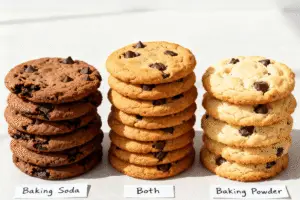
Difference Between Baking Soda and Baking Powder
The difference between baking soda and baking powder is one of the most common sources of confusion for home bakers. At first, they may look identical. Both are fine white powders but their composition, how they react in dough, and the results they create in cookies are very different. Understanding these differences is crucial if you want consistent texture, color, and flavor in your baking.
Baking Soda (Sodium Bicarbonate, or “Soda”)
Baking soda is pure sodium bicarbonate. It’s relatively inexpensive and is available in different particle sizes such as free running grade, refined standard grade, and fine granular. Each can be used in baking, but coarser grades dissolve more slowly. If not fully dispersed, they can leave dark brown specks on cookie or biscuit surfaces.
- How it works: Baking soda requires an acidic ingredient (like brown sugar, lemon juice, or molasses) plus moisture to activate. The reaction releases carbon dioxide gas, creating air pockets in dough.
- Role in cookies: Helps cookies spread, darken in color, and develop a chewy texture with rich flavor.
- Industry insight: In the biscuit industry, sodium bicarbonate is not only a leavening agent but also a way to adjust dough acidity for balanced flavor. To avoid premature reactions, soda is often added at the last stage of mixing with flour. Screening through a fine sieve ensures even dispersion.
- Caution: Too much soda can make cookies yellowish with an unpleasant “soda bite.”
This increase in spread is one of the most significant effects of using baking soda. If you’ve ever had issues with cookies turning into thin, greasy discs, this reaction is often the cause. You can learn about all the factors involved in my complete guide on why cookies spread too much.
Baking Powder (Balanced Mixture)
Baking powder is a complete leavening agent, containing baking soda, one or more acid salts (commonly cream of tartar or sodium acid pyrophosphate), and a stabilizer like cornstarch.
- How it works: When wet, and again when heated (in the case of double-acting powders), it releases carbon dioxide gas. This creates an even, open structure in baked goods.
- Role in cookies: Produces a lighter, fluffier, more cake-like texture with a neutral flavor.
- Industry insight: In large-scale biscuit production, it is unusual to use pre-blended baking powders. Instead of baking powder, baking soda (sodium bicarbonate) and acid salts are added separately for maximum control.
Quick Comparison Table
| Feature | Baking Soda | Baking Powder |
| Composition | 100% sodium bicarbonate | Sodium bicarbonate + acid salts + cornstarch |
| Activation | Needs an external acid + moisture | Self-contained (reacts with moisture & heat) |
| Cookie Texture | Chewy, spread-out, crisp edges | Fluffy, lighter, cake-like |
| Cookie Color | Darker, golden-brown | Lighter, pale |
| Flavor | Rich, slightly tangy if balanced | Neutral |
| Common Issues | Soda specks, yellowish color, soda bite if excess | Less browning, flatter flavor |
| Industry Practice | Added separately, often late in mixing | Rarely used pre-blended (except self-raising flour) |
How to Choose: When to Use Baking Soda vs Baking Powder in Cookies
One of the most common questions bakers ask is: when to use baking soda vs baking powder in cookies? The choice depends on your recipe’s ingredients, desired texture, and even the baking traditions behind the product.
When to Use Baking Soda in Cookies
- Best for recipes with natural acids. Use baking soda when your cookie dough includes acidic ingredients such as brown sugar, honey, yogurt, lemon juice, or molasses.
- Texture & color benefits. Baking soda encourages cookies to spread more, develop crisp edges, and turn a darker golden-brown thanks to enhanced Maillard reactions.
- Flavor profile. It can contribute a slight tang if not perfectly balanced, but when used correctly, it deepens flavor complexity.
Example: Classic chocolate chip cookies often rely on baking soda to achieve chewy centers with crisp edges.
When to Use Baking Powder in Cookies
- Best for recipes without acids. If your cookie dough has no natural acidic ingredients, baking powder provides the necessary acid-base reaction on its own.
- Texture & color benefits. Baking powder produces a lighter, fluffier, cake-like cookie with a paler surface color.
- Flavor profile. It’s neutral in taste, so it won’t alter the cookie flavor.
Example: Sugar cookies and shortbread-style cookies often use baking powder to create a soft, uniform texture.
The Professional’s Secret: Beyond Soda and Powder
In the biscuit industry, leavening is a carefully controlled science. Instead of relying solely on baking soda or baking powder, manufacturers often use ammonium bicarbonate as a primary leavening agent because of its rapid rate of action.
- Ammonium bicarbonate releases carbon dioxide and water quickly during baking, helping achieve perfectly shaped cookies with fine texture.
- To balance this, sodium bicarbonate (baking soda) and cream of tartar (acid salt) are added. These activate later, after the ammonium bicarbonate has done its job, allowing for more consistent rise, controlled spread, and even coloring.
- The combination provides both speed and stability, resulting in cookies that hold their shape while still developing good texture.
This dual or triple leavening approach gives professionals far more control over cookie structure than home bakers typically achieve with a single leavening agent.
Quick Takeaway
- Use baking soda if your recipe contains acidic ingredients and you want chewy, golden-brown cookies.
- Use baking powder if your recipe lacks acids and you prefer light, fluffy, cake-like cookies.
- Industry-level control: Combining ammonium bicarbonate, baking soda, and cream of tartar delivers precision and consistency in cookie production.
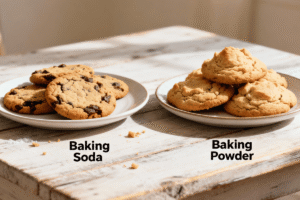
Recipe Examples 🍪
Chocolate Chip Cookies Without Baking Soda
Most chocolate chip cookies use baking soda for spread and chew. But what happens if you skip it? I tested it myself.
Ingredients:
- 1 cup (225g) unsalted butter, softened
- 1 cup (200g) granulated sugar
- 1 cup (200g) brown sugar
- 2 large eggs
- 2 tsp vanilla extract
- 3 cups (360g) all-purpose flour
- 2 tsp baking powder (instead of soda)
- ½ tsp salt
- 2 cups (340g) chocolate chips
Instructions:
- Preheat the oven to 350°F (175°C).
- Cream butter and sugar until light and fluffy (about 2 to 3 minutes).
- Add eggs and vanilla, mix well.
- In a separate bowl, whisk flour, baking powder, and salt.
- Combine wet and dry ingredients and mix for 3 minutes at slow speed. Stir in chocolate chips.
- Scoop dough balls onto a lined baking sheet.
- Bake for 10–12 minutes until the edges are golden.
👨🍳 My Results:
- Shape: Puffier than usual, less spread.
- Texture: More cakey, less chewy.
- Flavor: Still rich, but missing that caramelized chew.
💡 Industry Tip: If you want more chew without soda, cream the butter and sugar longer to incorporate air.
For example, chocolate chip cookies without soda may need adjustments in structure, similar to how flour choice changes texture in the best flour for cookies.
Cookies Without Baking Soda (Basic Dough)
This test was all about keeping the recipe simple: no baking soda, no powder.
Ingredients:
- 1 cup (225g) unsalted butter, softened
- 1 cup (200g) granulated sugar
- 2 cups (240g) all-purpose flour
- 1 tsp vanilla extract
- ¼ tsp salt
Instructions:
- Preheat the oven to 350°F (175°C).
- Cream butter and sugar until smooth.
- Mix in vanilla.
- Add flour and salt, stir until dough forms.
- Roll into balls, flatten slightly.
- Bake for 12–14 minutes until the edges are set.
👨🍳 My Results:
- Look: Pale, little to no spread.
- Texture: Crumbly, like shortbread.
- Flavor: Buttery but milder than classic cookies.
💡 Pro Tip: Add ¼ cup brown sugar for a deeper flavor and slight chew.
Sugar Cookies with Baking Powder
Sugar cookies are perfect for testing baking powder since they often need to hold their shape.
Ingredients:
- 1 cup (225g) unsalted butter, softened
- 1 cup (200g) granulated sugar
- 1 large egg
- 1 tsp vanilla extract
- 2 ¾ cups (330g) all-purpose flour
- 2 tsp baking powder
- ½ tsp salt
Instructions:
- Preheat the oven to 350°F (175°C).
- Cream butter and sugar until fluffy.
- Add egg and vanilla, beat until combined.
- In another bowl, whisk flour, baking powder, and salt.
- Mix dry into wet until a dough forms.
- Roll dough out, cut shapes, place on baking sheet.
- Bake for 8 –10 minutes, edges just set.
👨🍳 My Results:
- Shape: Smooth tops, no spreading.
- Texture: Light, tender, cake-like.
- Flavor: Clean vanilla taste, perfect for decorating.
💡 Pro Tip: For cut-out cookies (holiday cookies, decorated sugar cookies), baking powder is better than soda since it keeps shapes sharp.
👉 Final Takeaway (From 17 Years in the Cookie Industry):
Baking soda brings chew, spread, and caramelized flavor. Baking powder brings softness, lift, and shape control. If you want the best of both, use a blend of soda and powder — it’s a trick we use in the biscuit industry when precision is key.
Baking Soda vs Baking Powder in Cookies – Results at a Glance
| Factor | With Baking Soda | With Baking Powder | Without Either |
| Spread | More spread, flatter cookies | Less spread, puffier cookies | Very little spread |
| Texture | Chewy, crisp edges | Softer, cakier | Crumbly, shortbread-like |
| Color | Deeper golden brown | Lighter color | Pale |
| Flavor | Slight tang, more caramelized | Clean, mild, vanilla-forward | Buttery but plain |
| Best For | Chocolate chip, oatmeal, chewy cookies | Sugar cookies, cut-outs, shaped cookies | Shortbread, butter cookies |
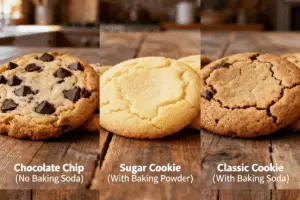
Substitutions & Replacements
Sometimes you run out of one ingredient and wonder if you can swap it with the other. Let’s clear up the confusion.
Can I Use Baking Powder Instead of Baking Soda?
Yes — but your cookies will turn out softer, puffier, and lighter in color. Baking powder already has acid inside, so it doesn’t need an external acid (like brown sugar or yogurt) to activate.
- To Replace 1 tsp Baking Powder: Use ¼ tsp Baking Soda + ½ tsp Cream of Tartar+¼ tsp corn starch.
- Be careful: too much can make cookies taste slightly bitter.
👉 Best for: sugar cookies or puffed cookies where you want more lift and less spread.
Can I Use Baking Soda Instead of Baking Powder?
Yes — but the results will be very different. Baking soda is 3–4 times stronger than baking powder, and it needs acid to activate.
- To Replace 1 tsp Baking Soda: Use 3 tsp Baking Powder. (Note: Cookie will be puffier)
- Without an acid, your cookies may taste bitter or develop a yellowish crumb (known as soda bite in the industry).
👉 Best for: recipes already rich in acids (like chocolate chip cookies with brown sugar or buttermilk).
Baking Soda Substitute for Cookies
If you don’t have baking soda:
- Use baking powder (3x the amount) for a softer, cakier cookie.
- For chewier cookies, a trick I’ve used in my test kitchen is combining 2 parts baking powder + 1 part cornstarch. It slows the reaction and mimics soda’s spreading effect.
👨🍳 Industry Insight (from my 17 years in cookie production):
In factories, we don’t typically swap soda for powder — instead, we design formulas with the exact leavening action needed. For example, we may add ammonium bicarbonate first (quick lift), then soda + cream of tartar (delayed action) to balance texture. Home bakers can manage this by mixing small amounts of both leaveners instead of substituting one fully.
Sometimes substitutes change the chewiness, like in cases where bakers ask why are my cookies too soft
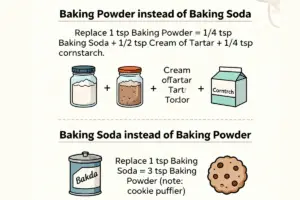
Baking Soda vs Baking Powder Taste in Cookies
Beyond texture and rise, taste is one of the biggest differences between baking soda and baking powder in cookies.
Baking Soda Taste in Cookies
- Baking soda is pure sodium bicarbonate. If not balanced with enough acid, it leaves a soapy, metallic, or bitter aftertaste — known in the industry as “soda bite.”
- When properly neutralized (with brown sugar, molasses, yogurt, or cocoa powder), soda enhances flavors and contributes to a richer, deeper cookie profile.
- Soda also speeds up browning through the Maillard reaction, giving your cookies a caramelized, slightly nutty taste.
👉 Best for: chocolate chip cookies, gingerbread, or recipes with strong acidic ingredients.
Baking Powder Taste in Cookies
- Baking powder contains both soda and acid, so it’s “self-balancing.” This means it rarely leaves a bitter aftertaste.
- The flavor is neutral to slightly salty, allowing the butter, sugar, and vanilla to shine through.
- Cookies made with baking powder often taste cleaner, lighter, and more delicate.
👉 Best for: sugar cookies, shortbread, or recipes where you want a mild, buttery taste.
👨🍳 Industry Insight (from 17 years in cookies):
In large-scale biscuit production, we avoid overdosing soda because even small excess leaves an unpleasant “bite” that customers immediately notice. That’s why we carefully check soda particle size and well dispersion in the dough.
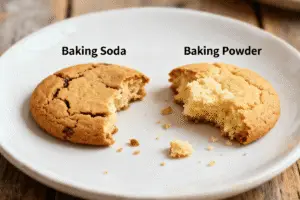
Common Mistakes with Baking Soda vs Baking Powder in Cookies
| Mistake | What Happens in Cookies | Fix |
| Too much baking soda | Yellowish color, bitter “soda bite” | Measure carefully, sieve soda before use |
| Not enough acid with baking soda | Flat, overspread cookies | Pair with brown sugar, honey, or replace part with baking powder |
| Too much baking powder | Bitter/metallic taste | Whisk into flour evenly, use exact amounts |
| Coarse or lumpy soda | Dark brown specks on cookie surface | Sieve soda before mixing |
| Substituting soda for powder (or vice versa) | Dense, odd flavor, poor rise | Remember: soda needs acid; powder has acid built-in |
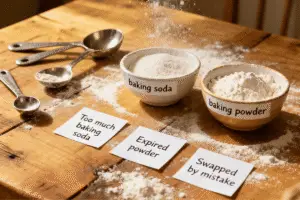
Conclusion: Mastering Baking Soda vs Baking Powder in Cookies
Baking soda and baking powder may look similar, but their impact on cookies couldn’t be more different. Baking soda creates spread, crispiness, and deep flavor when paired with the right acids, while baking powder ensures lift and a lighter crumb thanks to its built-in acid. In the biscuit and cookie industry, we often combine leavening agents like ammonium bicarbonate, sodium bicarbonate, and cream of tartar to achieve consistent results at scale.
For home bakers, the key is understanding when to use which:
- Use baking soda when your recipe has acidic ingredients like brown sugar, honey, or yogurt.
- Use baking powder when you need to lift without extra acidity.
- And when in doubt? Sometimes, the best recipes use both for a balance of spread and structure.
After 17 years in the cookie industry, I can confidently say: mastering these tiny white powders is one of the biggest game-changers for better cookies. Once you understand how they work, you’ll bake with precision, avoid common mistakes, and get consistent, bakery-quality results every time.
If you’d like a full overview of ingredient roles, check out how ingredients affect cookie texture for deeper insight.

